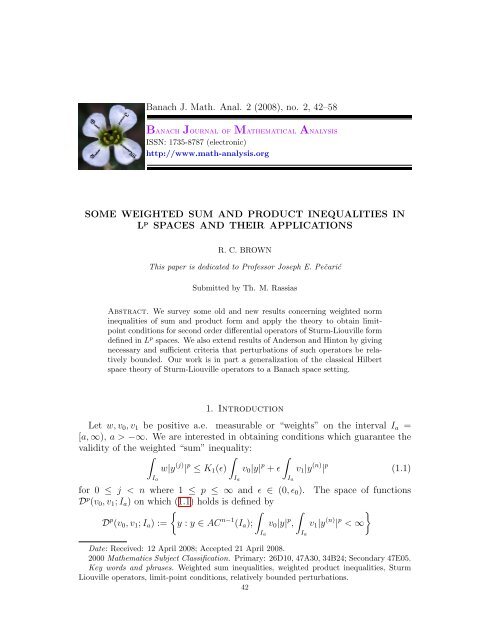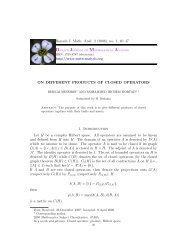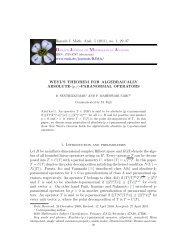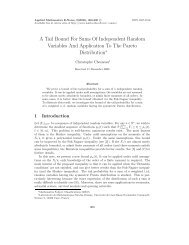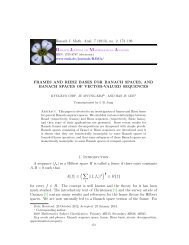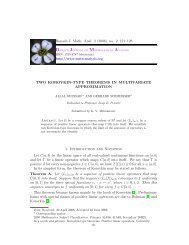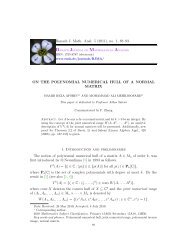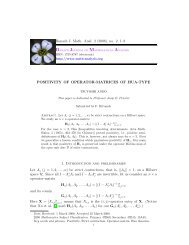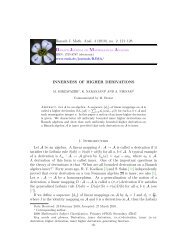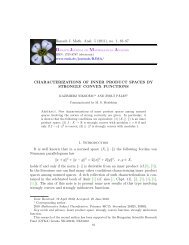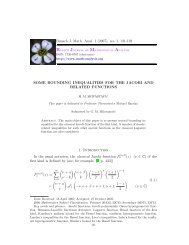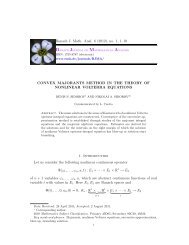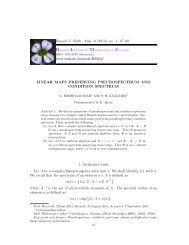Some weighted sum and product inequalities in L^ p spaces and ...
Some weighted sum and product inequalities in L^ p spaces and ...
Some weighted sum and product inequalities in L^ p spaces and ...
Create successful ePaper yourself
Turn your PDF publications into a flip-book with our unique Google optimized e-Paper software.
Banach J. Math. Anal. 2 (2008), no. 2, 42–58Banach Journal of Mathematical AnalysisISSN: 1735-8787 (electronic)http://www.math-analysis.orgSOME WEIGHTED SUM AND PRODUCT INEQUALITIES INL p SPACES AND THEIR APPLICATIONSR. C. BROWNThis paper is dedicated to Professor Joseph E. PečarićSubmitted by Th. M. RassiasAbstract. We survey some old <strong>and</strong> new results concern<strong>in</strong>g <strong>weighted</strong> norm<strong><strong>in</strong>equalities</strong> of <strong>sum</strong> <strong>and</strong> <strong>product</strong> form <strong>and</strong> apply the theory to obta<strong>in</strong> limitpo<strong>in</strong>tconditions for second order differential operators of Sturm-Liouville formdef<strong>in</strong>ed <strong>in</strong> L p <strong>spaces</strong>. We also extend results of Anderson <strong>and</strong> H<strong>in</strong>ton by giv<strong>in</strong>gnecessary <strong>and</strong> sufficient criteria that perturbations of such operators be relativelybounded. Our work is <strong>in</strong> part a generalization of the classical Hilbertspace theory of Sturm-Liouville operators to a Banach space sett<strong>in</strong>g.1. IntroductionLet w, v 0 , v 1 be positive a.e. measurable or “weights” on the <strong>in</strong>terval I a =[a, ∞), a > −∞. We are <strong>in</strong>terested <strong>in</strong> obta<strong>in</strong><strong>in</strong>g conditions which guarantee thevalidity of the <strong>weighted</strong> “<strong>sum</strong>” <strong>in</strong>equality:∫∫ ∫w|y (j) | p ≤ K 1 (ɛ) v 0 |y| p + ɛ v 1 |y (n) | p (1.1)I a I a I afor 0 ≤ j < n where 1 ≤ p ≤ ∞ <strong>and</strong> ɛ ∈ (0, ɛ 0 ). The space of functionsD p (v 0 , v 1 ; I a ) on which (1.1) holds is def<strong>in</strong>ed by{∫ ∫}D p (v 0 , v 1 ; I a ) := y : y ∈ AC n−1 (I a ); v 0 |y| p , v 1 |y (n) | p < ∞I a I aDate: Received: 12 April 2008; Accepted 21 April 2008.2000 Mathematics Subject Classification. Primary: 26D10, 47A30, 34B24; Secondary 47E05.Key words <strong>and</strong> phrases. Weighted <strong>sum</strong> <strong><strong>in</strong>equalities</strong>, <strong>weighted</strong> <strong>product</strong> <strong><strong>in</strong>equalities</strong>, SturmLiouville operators, limit-po<strong>in</strong>t conditions, relatively bounded perturbations.42
SUM INEQUALITIES IN L p SPACES 43where AC j (I a ) denotes the class of functions whose j-th derivative is locallyabsolutely cont<strong>in</strong>uous on I a . We shall also show the <strong>in</strong>equality (1.1) often impliesthe “<strong>product</strong>” <strong>in</strong>equality∫I av 1 |y (j) | p ≤ K 2(∫I av 1 |y| p ) n−jn(∫ I av 1 |y (n) | p ) jn.It will turn out that (1.1) has a number of <strong>in</strong>terest<strong>in</strong>g applications to problems <strong>in</strong>concern<strong>in</strong>g second-order differential operators determ<strong>in</strong>ed by symmetric expressionsof the form −(ry ′ ) ′ + qy <strong>and</strong> def<strong>in</strong>ed <strong>in</strong> L p <strong>spaces</strong>. The results generalizeboth some aspects of the Hilbert theory presented <strong>in</strong> the book of Naimark [23]<strong>and</strong> criteria obta<strong>in</strong>ed by Anderson <strong>and</strong> H<strong>in</strong>ton <strong>in</strong> [1] that perturbations of suchoperators <strong>in</strong> the L 2 sett<strong>in</strong>g be relatively bounded. We close this section with a fewremarks on notation. Upper case letters such as K or C denote constants whosevalue may change from l<strong>in</strong>e to l<strong>in</strong>e. We dist<strong>in</strong>guish between different constants bywrit<strong>in</strong>g K 1 , K 2 , C, C 1 , . . . , etc. K(·) <strong>in</strong>dicates dependence on a parameter, e.g.,K 1 (ɛ). L p (I a ) signifies the (complex) L p space on I a hav<strong>in</strong>g the norm(∫ ) 1/p||u|| p,Ia := |u| p .I aC ∞ (I a ) <strong>and</strong> C j (I a ) respectively denote the <strong>in</strong>f<strong>in</strong>itely or j-fold differentiable functionshav<strong>in</strong>g cont<strong>in</strong>uous j-th derivative on I a <strong>and</strong> C ∞ 0 (I a ) or C j 0(I a ) consists ofthe subspace of C ∞ (I a ) or C j (I a ) hav<strong>in</strong>g compact support. A local property is<strong>in</strong>dicated by the subscript “loc”, e.g., f ∈ L p loc (I), etc. Also, we write AC0 (I a )as AC(I a ) <strong>and</strong> L 1 (I a ) as L(I a ), <strong>and</strong> when the context is clear we abbreviateD p (v 0 , v 1 ; I a ) by “D p .” If T : X → Y is an operator where X <strong>and</strong> Y are Banach<strong>spaces</strong> D(T ), R(T ), G(T ), <strong>and</strong> N (T ) respectively denote the doma<strong>in</strong>, range,graph, <strong>and</strong> null space of T . F<strong>in</strong>ally, if f <strong>and</strong> g are two functions the notationf ≈ g means that there are constants C 1 <strong>and</strong> C 2 such that f ≤ C 1 g <strong>and</strong> g ≤ C 2 f.2. <strong>Some</strong> <strong>weighted</strong> norm <strong><strong>in</strong>equalities</strong> of <strong>sum</strong> formSuppose that f is a positive cont<strong>in</strong>uous function on I a . Let J t,ɛ := [t, t + ɛf(t)].For 1 < p < ∞ set[] ∫ ] p/p ′S 1 (t) := f −jp (ɛf)∫J −1 w[(ɛf) −1 (2.1)t,ɛS 2 (t) := f (n−j)p [(ɛf) −1 ∫J t,ɛw] [(ɛf) −1 ∫v −p′ /p0J t,ɛv −p′ /p1J t,ɛ] p/p ′(2.2)where p ′ = p/(p − 1). In the case that p = 1 or ∞ some modifications <strong>in</strong> thesedef<strong>in</strong>itions are required. If p = 1 we substitute the L ∞ norm of v −1i , i = 0, 1, onJ t,ɛ for the <strong>in</strong>tegral term. For <strong>in</strong>stance,[]S 1 (t) := f −j (ɛf)∫J −1 w ‖v −1 ‖ ∞,Jt,ɛ .t,ɛ
44 R.C. BROWNAnd when p = ∞ we writeSimilar changes apply to S 2 (t).S 1 (t) := f −j ‖w‖ ∞,Jt,ɛ[(ɛf) −1 ∫v0−1J t,ɛTheorem A. Suppose 1 ≤ p ≤ ∞. If there exists f <strong>and</strong> ɛ 0 ∈ (0, ∞] such thatS 1 (ɛ 0 ) := sup S 1 (t) < ∞t∈I a, 0
SUM INEQUALITIES IN L p SPACES 45Theorem 2.1. Let f <strong>and</strong> J t,ɛ be as above. Suppose that there is a constant Knot depend<strong>in</strong>g on t (but possibly on ɛ) such thata.e. on J t,ɛ . If p = 1, ∞ as<strong>sum</strong>e also thatv 0 (s)v 0 (t) , v 1(s)v 1 (t) ≥ K (2.7)w(s)w(t) ≤ K 1 (2.8)a.e. on J t,ɛ . Then the <strong>sum</strong> <strong>in</strong>equality (2.5) holds on D p for 1 ≤ p < ∞ ifT 1 (ɛ 0 ) :=T 2 (ɛ 0 ) :=sup f −jp wv0 −1 < ∞ (2.9)t∈I a,0
46 R.C. BROWN<strong>and</strong> S 2 (t) by replac<strong>in</strong>g the <strong>in</strong>tervals J t,ɛ by ∆ t,ɛ , then (2.5) is readily seen to holdon each Γ j , 1 ≤ j ≤ l. Hence,∫∫ }w|y∫Γ (j) | p ≤ K 1{ɛ −jη v 0 |y| p + ɛ (n−j)η v 1 |y (n) | p ,jso that∫Iw|y (j) | p ≤ lK 1{ɛ −jη ∫IIv 0 |y| p + ɛ (n−j)η ∫IIv 1 |y (n) | p }.How can conditions like (2.3), (2.4), (2.9), (2.10), or (2.11), (2.12) be verified?Essentially, as we have already <strong>in</strong> part done <strong>in</strong> Theorem 2.1, we will want tochoose f so that v i (s) ≈ v i (t), i = 0, 1, <strong>and</strong> w(s) ≈ w(t) on J t,ɛ . In a very generalcase this can always be done as we now demonstrate.Proposition 2.4. Suppose that w, v 0 , <strong>and</strong> v 1 are cont<strong>in</strong>uous on I a . Then thereexists a positive function f ∗ depend<strong>in</strong>g on t <strong>and</strong> possibly ɛ such12 ≤ w(s)w(t) , v 0(s)v 0 (t) , v 1(s)v 1 (t) ≤ 3 2(2.13)on J t,ɛ . Moreover, the sequence {t j } def<strong>in</strong>ed as <strong>in</strong> Theorem A us<strong>in</strong>g f ∗ has nof<strong>in</strong>ite limit po<strong>in</strong>t.Proof. Given t ≥ a, ɛ > 0, <strong>and</strong> for i = 0, 1 let f i (t, ɛ) := (s i (t) − t)/ɛ wheres i (t) = m<strong>in</strong>{t + ɛ, sup{z > t : 3v i (t)/2 ≥ v i (u) ≥ v i (t)/2 for u ∈ (t, z]}. (2.14)Def<strong>in</strong>e s 2 (t) <strong>and</strong> f 2 (t, ɛ) similarly for w <strong>and</strong> set f ∗ (t, ɛ) = m<strong>in</strong>{f i (t, ɛ)}, i = 0, 1, 2.With this construction of f ∗ (2.13) follows. To prove the second assertion Sets ∗,0 := a < · · · < s ∗,j+1 := s ∗,j + ɛf ∗ (s ∗,j , ɛ) ≡ s 0 (s ∗,j )<strong>and</strong> suppose that {s ∗,j } converges to ¯s ∗ < ∞. We show that for all sufficientlylarge j <strong>and</strong> for u ∈ (s ∗,j , ¯s ∗ ] that 3v i (s ∗,j )/2 ≥ v i (u) ≥ v i (s ∗,j )/2. If this is notso then for every j there is a k > j <strong>and</strong> a u ∗ ∈ [s ∗,k , ¯s ∗ ] such that for one of theweights, say, v 0 either (i) v 0 (s ∗,k )/2 > v 0 (u ∗ ) or (ii) 3v 0 (s ∗,k )/2 < v 0 (u ∗ ). Butfrom the cont<strong>in</strong>uity <strong>and</strong> positivity of v 0 , given, say, 1/10 > µ > 0 there is a jsuch that for any k > j <strong>and</strong> all u ∈ [s ∗,k , ¯s ∗ ] we have thatIf (i) is true then(1 − µ)v 0 (¯s ∗ ) < v 0 (u) < (1 + µ)v 0 (¯s ∗ ).(1 − µ)v 0 (¯s ∗ ) < v 0 (u ∗ ) < v 0 (s ∗,k )/2 < (1 + µ)v 0 (¯s ∗ )/2so that 9/10 < (1/2)(11/10) which is false. Similarly, if (ii) holds we have(3/2)(1 − µ)v 0 (¯s ∗ ) < (3/2)v 0 (s ∗,k ) < v 0 (u ∗ ) < (1 + µ)v 0 )(¯s ∗ )so that 27/20 < 11/10 which is also false. This argument shows that¯s ∗ ≤ s ∗ (s ∗,k ) = s ∗,k+1 < s ∗ (s ∗,k+1 ),<strong>and</strong> so ¯s ∗ cannot be a limit po<strong>in</strong>t of the sequence {s ∗,j }.□
SUM INEQUALITIES IN L p SPACES 47Remark 2.5. With this def<strong>in</strong>ition of f ∗ we see thatS 1 (t) ≈ f ∗−jp wv −10 (2.15)S 2 (t) ≈ f ∗(n−j)p wv −11 . (2.16)It is even simpler to def<strong>in</strong>e f ∗ so that (2.7) holds <strong>in</strong> Theorem 2.1 s<strong>in</strong>ce we can omitw <strong>and</strong> only consider the lower bounds <strong>in</strong> (2.14). We omit the details. In particular,this means that if the weights are cont<strong>in</strong>uous then the <strong>in</strong>tegral expressions (2.1)<strong>and</strong> (2.2) <strong>in</strong> Theorem A can <strong>in</strong> theory always be replaced by the po<strong>in</strong>t evaluationexpressions (2.15) <strong>and</strong> (2.16). Also, <strong>in</strong> Theorem 2.1 if the weights are cont<strong>in</strong>uousthen the conditions (2.7) will be satisfied if f ∗ is chosen. But while Proposition2.4 is of some theoretical <strong>in</strong>terest it is usually not of much practical use s<strong>in</strong>ce it isdifficult to characterize f ∗ <strong>in</strong> a convenient fashion from its def<strong>in</strong>ition. Fortunately,a satisfactory substitute for f ∗ is often suggested by the particular weights w, v 0 ,<strong>and</strong> v 1 .Example 2.6. Let a = 1, w(t) = t β , v 0 (t) = t γ , v 1 (t) = t α <strong>and</strong> f(t) = t δ whereδ ≤ 1. Then1 ≤ sups∈J t,ɛst −1 ≤ 1 + ɛt δ−1 ≤ 1 + ɛ.A calculation shows that S 1 (ɛ 0 ), S 2 (ɛ 0 ) are f<strong>in</strong>ite ifβ ≤ m<strong>in</strong> {δpj + γ, −δ(n − j)p + α} , (2.17)<strong>and</strong> any fixed ɛ 0 (say ɛ 0 = 1). In (2.17) β will be as large as possible relative toα <strong>and</strong> γ if δ is chosen by “equality”, i.e.,δ = (α − γ)/np ≤ 1. (2.18)With this choice of δ( ) n − jβ ≤ γn( j+ α .n)Example 2.7. Let w(t) = v 0 (t) = v 1 (t) = e t , a ≥ 0, <strong>and</strong> f(t) = 1.1 ≤ e s /e t ≤ ɛ on J t,ɛ . (2.5) follows.ThenIt was demonstrated <strong>in</strong> [7, Theorem 3.2] that either of the conditions (2.3) or(2.4) is necessary as well as sufficient for (2.5) provided the weights are chosenso that S 1 (t) ≈ S 2 (t). The choice of δ accord<strong>in</strong>g to (2.18) forces this <strong>in</strong> Example2.6.Example 2.8. Let v 0 = v 1 = w <strong>and</strong> take f(t) = 1. Then (2.5) is true if <strong>and</strong> onlyif( ∫ t+ɛ) ∫ t+ɛ) p/p ′sup ɛ −1 w(ɛ −1 w −p′ /p< ∞.t∈I a,0
48 R.C. BROWNTheorem 2.9. Let w, v 0 , v 1 be weights such that w, v −p′ /p0 , v −p′ /p1 ∈ L loc (I a ) <strong>and</strong>the follow<strong>in</strong>g conditions are satisfied:|v ′ 1| ≤ Kv 1−1/np1 v 1/np0 ,|v ′ 0| ≤ npv −1/np1 v 1+1/np0 (2.19)on I a . Then the <strong>sum</strong> <strong>in</strong>equality (2.5) holds for 1 < p < ∞ <strong>and</strong> j = 0, . . . , n − 1if <strong>and</strong> only ifS(ɛ 0 ) :=where f(t) = (v 1 /v 0 ) 1/np .1supt∈I a,ɛ∈(0,ɛ 0 ) ɛf(t)∫ t+ɛf(t)twv −j/n1 v (j−n)/n0 < ∞ (2.20)Before prov<strong>in</strong>g this we need a lemma show<strong>in</strong>g that our choice of f works likef ∗ <strong>in</strong> Proposition 2.4.Lemma 2.10. There are constants K 2 , K 3 > 0 possibly depend<strong>in</strong>g on ɛ so thatK 2 ≤ f(s)f(t) , v 1(s)v 1 (t) , v 0(s)v 0 (t) ≤ K 3 (2.21)on the <strong>in</strong>tervals J t,ɛ for sufficiently small ɛ > 0.Proof. First, we note that|f ′ | = ∣ ( (v 1 /v 0 ) 1/np) ∣ ′ ∣∣ = (1/np)(v 1 /v 0 ) 1/np−1 v0 −2 (v 0 v 1 ′ − v 1 v 0) ∣ ′ ≤ (1/np)v 1/np−11 v −1/np0 |v ′ 1| + (1/np)(v 1 /v 0 ) 1/np−1 v −20 v 1 |v ′ 0|≤ K/np + 1.Hence for t < s ≤ t + ɛf(t),|f(s) − f(t)| =∣∫ stf ′ ∣ ∣∣∣≤∫ st|f ′ | ≤ ɛf(t)(K/np + 1),so that f(s)/f(t) ≤ 1 + ɛ(K/np + 1) <strong>and</strong> f(s)/f(t) ≥ 1 − ɛ(K/np + 1). Next,consider v 0 . S<strong>in</strong>ce|fv ′ 0| ≤ (v 1 /v 0 ) 1/np npv 1+1/np0 v −1/np1 ,= npv 0<strong>and</strong> by the previous result we obta<strong>in</strong> thatv ′ 0/v 0 ≤ |v ′ 0/v 0 | ≤ np(1 − ɛ(K/np + 1))f(t)) −1 .Integrat<strong>in</strong>g this over J t,ɛ implies thatBut also s<strong>in</strong>cev 0 (s)/v 0 (t) ≤ exp(K 4 (ɛ)(s − t)/f(t))≤ exp(K 4 (ɛ)). (2.22)−v ′ 0/v 0 ≤ |v ′ 0/v 0 | ≤ np(1 − ɛ(K/np + 1))f(t)) −1 ,
we get by <strong>in</strong>tegration thatSUM INEQUALITIES IN L p SPACES 49v 0 (s)/v 0 (t) ≥ (exp(K 4 (ɛ))) −1 . (2.23)(2.21) for v 0 follows from (2.22) <strong>and</strong> (2.23). That (2.21) holds also for v 1 is aconsequence of the identityv 1 (s)/v 1 (t) = (v 0 (s)/v 0 (t)(f(s)/f(t)) np<strong>and</strong> (2.21) for v 0 <strong>and</strong> f.□Proof of Theorem 2.9. We know by Theorem A that the <strong>sum</strong> <strong>in</strong>equality (2.5)holds if (2.3) <strong>and</strong> (2.4) hold. However because of the conditions (2.21) allow<strong>in</strong>gf, v 0 , <strong>and</strong> v 1 to be taken <strong>in</strong> <strong>and</strong> out of <strong>in</strong>tegrals over the <strong>in</strong>terval J t,ɛ both conditionsare found to be equivalent to (2.20). S<strong>in</strong>ce the as<strong>sum</strong>ptions on the weightsguarantee that S 1 (t) = S 2 (t) we could apply [7, Theorem 3.2] to conclude that(2.20) is a necessary condition; but we choose to give an explicit argument. Letφ ≥ 0 be a C ∞ 0 function such that φ(t) = 1 on [0, 1] <strong>and</strong> φ has support on (−2, 2).Def<strong>in</strong>eH j (t) = φ(t)(t j /j!).Then H (j)j (t) = 1 on [0, 1] <strong>and</strong> H j (t) has support on (−2, 2). Set u = (s−t)/ɛf(t)for t − 2ɛf(t) ≤ s ≤ t + 2ɛf(t) <strong>and</strong> def<strong>in</strong>eNote thatH j,t (s) = (ɛf(t)) j H j (u).H (k)j,t(s) = H(k) (u)(ɛf(t)) j−kjso that <strong>in</strong> particular H (j)j,t (s) = 1. Next, choose t <strong>and</strong> sufficiently small ɛ suchthat t − 2ɛf(t) > a <strong>and</strong> consider the functionS(t) := (ɛf(t)) −1 ∫ t+ɛf(t)= (ɛf(t)) −1 ∫ t+ɛf(t)≈ (ɛf(t)) −1 (v −j/n×∫ t+ɛf(t)Therefore if (2.5) holds we havettt1 v j/n−1w|H (j)j,t |p .wv −j/n1 v j/n−10wv −j/n1 v j/n−10 |H (j)j,t |p0 )(t){∫ t+2ɛf(t)S(t) = O (ɛf(t)) −1 (v −j/n1 v j/n−10 )(t)[ɛ −jp+ɛ (n−j)p ∫ t+2ɛf(t)t−2ɛf(t)v 1 |H (n)j,t |p ]}.t−2ɛf(t)v 0 |H j,t | p
50 R.C. BROWNHowever<strong>and</strong>( ∫ )t+2ɛf(t)(ɛf(t)) −1 (v −j/n1 v 0 (t) j/n−1 )(t) v 0 |H j,t | pt−2ɛf(t)( ∫ )t+2ɛf(t)≈ f(t) −jp (ɛf(t)) −1 |H j,t | p=∫ 2−2|H j (u)| p ,(ɛf(t)) −1 (v −j/n1 v j/n−10 )(t)t−2ɛf(t)≈ f(t) −jp (v 1 /v 0 )(ɛf(t)) −1 )=∫ 2−2|H (n)j (u)| p .( ∫ t+2ɛf(t)t−2ɛf(t)( ∫ t+2ɛf(t))v 1 |H (n)j,t |pt−2ɛf(t))|H (n)j,t |pPutt<strong>in</strong>g these two estimates together shows that S(t) is uniformly bounded fort ∈ I a <strong>and</strong> ɛ ∈ (0, ɛ 0 ] which is equivalent to (2.20) as was to be proved. □Our next result extends an <strong>in</strong>equality of Anderson <strong>and</strong> H<strong>in</strong>ton [1, Theorem 3.1]from L 2 (I a ) to the L p case.Corollary 2.11. Suppose v 0 , v 1 ∈ L p loc (I a), v 1/21 |v ′ 0| ≤ 2v 3/20 , <strong>and</strong> |v ′ 1| ≤ (K/p) √ v 0 v 1then the <strong>sum</strong> <strong>in</strong>equalityholds for all 1 < p < ∞ <strong>and</strong> ɛ > 0.‖v ′ 1y ′ ‖ p,Ia ≤ K(ɛ)‖v 0 y‖ p,Ia + ɛ‖v 1 y ′′ ‖ p,Ia (2.24)Proof. Here the weights (v ′ 1) p , v p 0, <strong>and</strong> v p 1 replace the weights w, v 0 , <strong>and</strong> v 1 . Theconditions on v ′ 1 <strong>and</strong> v ′ 0 are equivalent to (2.19) for this choice of weights. f(t) isgiven by (v p 1/v p 0) 1/2p ≡ √ v 1 /v 0 . We have also thatS 1 (t) ≡ S 2 (t) = ɛ −1 √v0v 1∫ t+ɛ√v1 /v 0t|v ′ 1| p (v 1 v 0 ) −p/2 ≤ (K/p) p .(2.24) follows by Theorem 2.9. □Example 2.12. Suppose w = v 0 = v 1 <strong>and</strong> |v ′ 1| ≤ npv 1 . Then f = 1 <strong>and</strong>S 1 (∞) = S 2 (∞) = 1. By Theorem 2.9 we have the <strong>in</strong>equality∫I aw|y (j) | p ≤ K 1(ɛ −jp ∫I aw|y| p + ɛ (n−j)p ∫I aw|y (n) | p ). (2.25)In this example unlike Examples 2.7 <strong>and</strong> 2.8 s<strong>in</strong>ce the <strong>in</strong>equality holds for allɛ > 0.
SUM INEQUALITIES IN L p SPACES 51Remark 2.13. If a <strong>sum</strong> <strong>in</strong>equality of the form (2.5) holds for arbitrary ɛ > 0 wecan m<strong>in</strong>imize the right-h<strong>and</strong> side of the <strong>in</strong>equality as a function of ɛ providedj ≠ 0 <strong>and</strong> ∫ I av 1 |y (n) | p ≠ 0. This procedure applied to (2.25) <strong>in</strong> the previousexample will yield the <strong>product</strong> <strong>in</strong>equality∫I aw|y (j) | p ≤ K 2(∫I aw|y| p ) n−jn(∫ I aw|y (n) | p ) jn.Note that v 1 can be taken as e ±bt where 0 < b ≤ np.Remark 2.14. So far we have supposed because of the applications we have <strong>in</strong>m<strong>in</strong>d that each of the terms <strong>in</strong> our <strong>weighted</strong> <strong>sum</strong> or <strong>product</strong> <strong><strong>in</strong>equalities</strong> have acommon L p norm. However, versions of these <strong><strong>in</strong>equalities</strong> exist when the threenorms are different. One can have, for <strong>in</strong>stance, an <strong>in</strong>equality of the form{ [∫] ) p/tw|y∫I (j) | p ≤ K 1 v 1 |ya[∫I (m) | tawhere 1 ≤ p, s, t < ∞,ɛ −µ 1I av 0 |y| s ] p/s+ ɛ µ 2µ 1 = p(j + s −1 − p −1 )µ 2 = p(n − j − t −1 + p −1 ),<strong>and</strong> n, j, p, s, t satisfy various relationships. Also generalizations exist <strong>in</strong> R n , n >1. For <strong>in</strong>formation on these more general cases see [5], [7], [6], [9], <strong>and</strong> [11]. Thereare additionally other approaches to <strong>weighted</strong> norm <strong><strong>in</strong>equalities</strong> similar to (2.5).See for example Wojteczek-Laszczak [26] <strong>and</strong> Kwong <strong>and</strong> Zettl [22].3. <strong>Some</strong> Applications to Relative Boundedness <strong>and</strong> Limit-po<strong>in</strong>tconditions for differential operators <strong>in</strong> L p <strong>spaces</strong>In [11] we gave applications of <strong>sum</strong> <strong>and</strong> <strong>product</strong> <strong><strong>in</strong>equalities</strong> to various spectraltheoretic problems <strong>in</strong>volv<strong>in</strong>g Sturm-Liouville operators <strong>in</strong> L 2 (I a ). In this sectionwe look at applications to operators determ<strong>in</strong>ed by expressions of Sturm-Liouvilleform but def<strong>in</strong>ed <strong>in</strong> L p <strong>spaces</strong>. We first require some prelim<strong>in</strong>ary def<strong>in</strong>itions <strong>and</strong>abstract results. In what follows ‖(·)‖ will denote the norm <strong>in</strong> an arbitrary Banachspace.Def<strong>in</strong>ition 3.1. Suppose A <strong>and</strong> T are operators from a Banach space X to aBanach space Y . Then A is said to be T bounded if the doma<strong>in</strong> of T is conta<strong>in</strong>ed<strong>in</strong> the doma<strong>in</strong> of A <strong>and</strong> the <strong>in</strong>equality‖A(x)‖ ≤ K(‖x‖ + ‖T (x)‖) (3.1)holds for all x <strong>in</strong> the doma<strong>in</strong> of T . Furthermore A is said to have T bound 0 if Ais T bounded <strong>and</strong> the <strong>in</strong>equality (3.1) has the formfor all ɛ ∈ (0, ɛ 0 ) for some ɛ 0 ∈ (0, ∞).‖A(x)‖ ≤ K(ɛ)‖x‖ + ɛ‖T (x)‖)
52 R.C. BROWNLemma 3.2. Suppose A, B, C, <strong>and</strong> L are operators from a Banach space X toa Banach space Y . Suppose that A is L-bounded <strong>and</strong> B, C are L-bounded with Lbound 0. Then A is L + B + C bounded.Proof. By the triangle <strong>in</strong>equality‖x‖ + ‖L(x)‖ ≤ ‖x‖ + ‖(L + B + C)(x)‖ + ‖B(x)‖ + ‖C(x)‖. (3.2)¿From the hypotheses on B <strong>and</strong> C we also have the estimates‖B(x)‖ ≤ K 1 (ɛ/2)‖x‖ + (ɛ/2)‖L(x)‖ (3.3)‖C(x)‖ ≤ K 2 (ɛ/2)‖x‖ + (ɛ/2)‖L(x)‖. (3.4)Substitut<strong>in</strong>g (3.3) <strong>and</strong> (3.4) <strong>in</strong>to (3.2 gives that(1 − ɛ)(‖x‖ + ‖L(x)‖) ≤ (1 + K 1 (ɛ/2) + K 2 (ɛ/2))‖x‖ + ‖(L + B + C)(x)‖.(3.5)But s<strong>in</strong>ce A is L bounded ‖A(x)‖ ≤ K(‖x‖ + ‖L(x)‖). Comb<strong>in</strong><strong>in</strong>g this with (3.5)yields that‖A(x)‖ ≤ K(1 − ɛ) −1 [(1 + K 1 (ɛ/2) + K 2 (ɛ/2))‖x‖ + ‖(L + B + C)(x)‖].Lemma 3.3. Let A, B, C <strong>and</strong> L be operators from a Banach space X to aBanach space Y . Suppose the <strong><strong>in</strong>equalities</strong>‖A(y)‖ ≤ K(ɛ)‖B(y)‖ + ɛ‖L(y)‖) (3.6)‖B(y)‖ ≤ K(ɛ)‖C(y)‖ + ɛ‖L(y)‖ (3.7)‖C(y)‖ ≤ K(‖y‖ + ‖T (y)‖) (3.8)where T (y) = (A + B + L)(y). Then A is T bounded with relative bound 0.Proof. By (3.7) <strong>and</strong> the triangle <strong>in</strong>equality‖B(y)‖ ≤ K(ɛ)‖C(y)‖ + ɛ‖(L + B)(y)‖ + ɛ‖B(y)‖.Hence,‖B(y)‖ ≤ K(ɛ)(1 − ɛ) −1 ‖C(y)‖ + ɛ(1 − ɛ) −1 ‖(L + B)(y)‖.Substitut<strong>in</strong>g this <strong>in</strong>to (3.6) after not<strong>in</strong>g aga<strong>in</strong> that ‖L(y)‖ ≤ ‖(L + B)(y)‖ +‖B(y)‖ gives the <strong>in</strong>equalityF<strong>in</strong>ally,‖A(y)‖ ≤ K(ɛ)(1 + ɛ(1 − ɛ) −1 )‖C(y)‖ + ɛ 2 (1 − ɛ) −1 ‖(L + B)(y)‖. (3.9)‖(L + B)(y)‖ ≤ ‖T (y) + ‖C(y)‖≤ K‖y‖ + (K + 1)‖T (y)‖.Substitution <strong>in</strong>to (3.9) now gives the desired conclusion.Given a Banach space X with dual X ∗ , [x, x ∗ ] signifies the complex conjugatex ∗ (x) for x ∈ X <strong>and</strong> x ∗ ∈ X ∗ . If T is an operator on X we consider the set ofpairs G(T ∗ ) := (z, z ′ ) ∈ X × X ∗ such that[T (y), z] = [y, z ′ ]. (3.10)□□
SUM INEQUALITIES IN L p SPACES 53The density of D(T ) implies that (3.10) determ<strong>in</strong>es an operator T ∗ called theadjo<strong>in</strong>t of T such that T ∗ (z) = z ′ . If T : X ∗ → X ∗ has a doma<strong>in</strong> D(T ) which istotal over X (i.e., [x, x ∗ ] = 0 for a fixed x ∈ X <strong>and</strong> all x ∗ ∈ D(T ) ⇒ x = 0) theset G( ∗ T ) of pairs (y ′ , y) ∈ X × X satisfy<strong>in</strong>g[y ′ , z] = [y, T (z)]also determ<strong>in</strong>es an operator which we denote by ∗ T <strong>and</strong> call the adjo<strong>in</strong>t of T <strong>in</strong>X. 1 Both T ∗ <strong>and</strong> ∗ T are closed <strong>and</strong> [T (y), z] = [y, T ∗ (z)] or [ ∗ T (y), z] = [y, T (z)]for all y ∈ D(T ) or D( ∗ T ) ⊂ X <strong>and</strong> z ∈ D(T ∗ ) or D(T ) ⊂ X ∗ . In the particularcase X = L p (I a ) <strong>and</strong> X ∗ = L p′ (I a ) where 1 ≤ p ≤ ∞ the pair<strong>in</strong>g [(·), (·)] onL p (J) × L p′ (J) for some <strong>in</strong>terval J is given by [y, z] J := ∫ y¯z. Consider now theJdifferential expression M[y] := −(ry ′ ) ′ + qy. As<strong>sum</strong>e that r > 0, r ∈ C 1 (I a ), <strong>and</strong>q ∈ C(I a ). Def<strong>in</strong>e{y, z}(t) := r(t)(y(t)¯z ′ (t) − y ′ (t)¯z(t)).for y, z ∈ AC loc (I a ) <strong>and</strong> the follow<strong>in</strong>g operators <strong>and</strong> doma<strong>in</strong>s <strong>in</strong> L p (I a ).Def<strong>in</strong>ition 3.4. For p ∈ [1, ∞] let let T ′ 0,p, T p , T 0,p , <strong>and</strong> be the operators withdoma<strong>in</strong> <strong>and</strong> range <strong>in</strong> L p (I a ) determ<strong>in</strong>ed by M onD ′ 0,p := {y ∈ C ∞ 0 (I a )},D p := {y ∈ L p (I a ) : y ′ ∈ AC loc (I a ); M[y] ∈ L p (I a )},D 0,p := {y ∈ D p : y(a) = y ′ (a) = 0; limt→∞{y, z}(t) = 0, ∀z ∈ D p ′}.We call T ′ 0,p, T 0,p respectively the “prem<strong>in</strong>imal” <strong>and</strong> “m<strong>in</strong>imal” operators, <strong>and</strong> T pthe “maximal” operator determ<strong>in</strong>ed by M.Theorem B. If 1 ≤ p < ∞ the operators T ′ 0,p, T 0,p , <strong>and</strong> T p have the follow<strong>in</strong>gproperties:(i) T 0,p <strong>and</strong> T p are closed densely def<strong>in</strong>ed operators.(ii) [T p (y), z] [a,t] = {y, z}(t) − {y, z}(a) + [y, T p ′(z)] [a,t] .(iii) T ∗ p = T 0,p ′ <strong>and</strong> T ∗ 0,p = T p ′.(iv) T ′ 0,p is closable <strong>and</strong> T ′ 0,p = T 0,p .Moreover, T 0,∞ <strong>and</strong> T ∞ are closed, the closure of T ′ 0,∞ is T 0,∞ , ∗ T 0,∞ = T 1 , <strong>and</strong>∗ T ∞ = T 0,1 .Proofs of (i)–(iii), the last statement, as well as more general results may be found<strong>in</strong> one of [18, Chapter VI], [25], or [13]). The L 2 theory is thoroughly treated<strong>in</strong> Naimark [23, §17]. It is almost certa<strong>in</strong> that by extend<strong>in</strong>g the procedure ofNaimark given <strong>in</strong> the L 2 case that q, r <strong>and</strong> r −p′ /p need only be locally <strong>in</strong>tegrablefor Theorem B to hold. However, the verification of this is technically complicated<strong>and</strong> will be omitted here.Def<strong>in</strong>ition 3.5. The operators T 0,p or T p are separated if on D 0,p or D p (ry ′ ) ′ ∈L p (I a )1 Goldberg calls this operator the preconjugate of T . Its properties are studied <strong>in</strong> [18, VI.I].
54 R.C. BROWNRemark 3.6. By the triangle <strong>in</strong>equality the separation of T 0,p or T p is equivalentto qy ∈ L p (I a ) on the doma<strong>in</strong>s of these operators. The closed graph theorem <strong>in</strong>turn implies that separation is equivalent to the existence of an <strong>in</strong>equality of theform‖(ry ′ ) ′ ‖ p,Ia + ‖qy‖ p,Ia ≤ K{‖y‖ p,Ia + ‖M[y]‖ p,Ia }.Necessary <strong>and</strong> sufficient conditions for separation <strong>in</strong> L p when M[y] = −y ′′ + qyhave been given by Chernyavskaya <strong>and</strong> Shuster [14]. However their conditionscan be difficult to verify. For p = 2 various sufficient conditions may be found <strong>in</strong>[12], [10], [2], [16]. The simplest condition guarantee<strong>in</strong>g separation for all p is torequire that q be essentially bounded.Limit-po<strong>in</strong>t Results <strong>in</strong> L p <strong>spaces</strong>.Def<strong>in</strong>ition 3.7. We say that T p is p-limit-po<strong>in</strong>t (p-LP) at ∞ if lim t→∞ {y, z}(t) =0 for all y ∈ D p <strong>and</strong> z ∈ D p ′Theorem 3.8. Consider the follow<strong>in</strong>g conditions:(i) T p is p-LP.(ii) There do not exist l<strong>in</strong>early <strong>in</strong>dependent solutions y p ∈ L p (I a ) <strong>and</strong> z p ′L p′ (I a ) of M[y] = 0.(iii) dim D p /D 0,p = 2.Then (i) <strong>and</strong> (iii) are equivalent conditions <strong>and</strong> (i) ⇒ (ii).Proof. Suppose that (i) is true <strong>and</strong> that there were l<strong>in</strong>early <strong>in</strong>dependent solutionsy p ∈ L p (I a ) <strong>and</strong> z p ′ ∈ L p′ (I a ). Let t ∈ I a By (ii) of Theorem B {y, z}(t) ={y, z}(a) <strong>and</strong> the fact that T p is p-LP we have0 = limt→∞{y p , z p ′}(t) = {y p , z p ′}(a) = r −1 (a){y p , z p ′}(a).But this is impossible s<strong>in</strong>ce r −1 {y, z} is just the Wronskian of of the solutionsy p , z p ′ <strong>and</strong> its zero value at a or t contradicts their as<strong>sum</strong>ed l<strong>in</strong>ear <strong>in</strong>dependence.Turn<strong>in</strong>g now to (iii), let φ 1 <strong>and</strong> φ 2 be C0 ∞ (I a ) functions such that φ 1 (a) = 1,φ ′ 1(a) = 0 <strong>and</strong> φ 2 (a) = 0, φ ′ 2(a) = 1. S<strong>in</strong>ce φ 1 , φ 2 ∈ D p <strong>and</strong> are l<strong>in</strong>early <strong>in</strong>dependent,we see that dim D p /D 0,p ≥ 2. Suppose there exists u ∈ D p such that{φ 1 , φ 2 , u} is l<strong>in</strong>early <strong>in</strong>dependent mod D 0,p . Let h be a l<strong>in</strong>ear comb<strong>in</strong>ation ofthese functions such that h(a) = h ′ (a) = 0. Let G p <strong>and</strong> G 0,p respectively be D por D 0,p endowed with the graph norm. Now the dual G ∗ p of G p can be identifiedwith the space of pairs ξ = (z, z ∗ ) <strong>in</strong> L p′ (I a ) × L p′ (I a ) such that ξ(y), y ∈ G p , isgiven by∫y¯z +I a∫M[y]¯z ∗ .I aS<strong>in</strong>ce h /∈ G 0,p <strong>and</strong> G 0,p is closed <strong>in</strong> G p there exists an element ξ ∈ G ∗ p such thatξ(h) = 1 <strong>and</strong> ξ(y) = 0 for all y ∈ G 0,p , imply<strong>in</strong>g that ξ = (−M[z ∗ ], z ∗ ) for somez ∈ D p . It follows that1 = ξ(h) =∫h(−M[z] +I a∫M[h]¯zI a= {h, z}(∞),∈
SUM INEQUALITIES IN L p SPACES 55contradict<strong>in</strong>g (i). We conclude that dim D/D 0 = 2. In the above argument wehave shown that (i)⇒ (ii) <strong>and</strong> that (i)⇒ (iii). It is clear that (iii) ⇒ (i). For ifD p is a two dimensional extension of D 0,p then span{φ 1 , φ 2 , D 0,p } = D p . S<strong>in</strong>ce φ 1<strong>and</strong> φ 2 have compact support <strong>and</strong> by the def<strong>in</strong>ition of D 0,p , (i) will hold. □Remark 3.9. For p ≠ 2 Theorem 3.8 represents an extension of the well-knownlimit po<strong>in</strong>t concept for differential operators <strong>in</strong> L 2 (I a ). In particular (ii) is ageneralization of the fact that if M is 2-LP at ∞ then M has at most one L 2solution. In the limit<strong>in</strong>g case p = 1, p ′ = ∞, if there is a solution y <strong>in</strong> D 1<strong>in</strong> L(I a ), (ii) says that that there cannot be another solution <strong>in</strong>dependent of ywhich is bounded. As <strong>in</strong> the Hilbert space case we have also shown that T p isp-limit-po<strong>in</strong>t if <strong>and</strong> only if D p /D 0,p = 2.Remark 3.10. If any one of T 0,p , T p , T 0,p ′ <strong>and</strong> T p ′ has closed range then more can besaid. Specifically all the other m<strong>in</strong>imal <strong>and</strong> maximal operators also have closedrange. In particular, the m<strong>in</strong>imal operators are one-to-one <strong>and</strong> have bounded<strong>in</strong>verses while the maximal operators are surjective <strong>and</strong>dim (D p /D 0,p ) = dim N (T p ) + dim N (T p ′).For the proof <strong>in</strong> a considerably more general sett<strong>in</strong>g see Goldberg [18] TheoremsVI.2.7 <strong>and</strong> VI.2.11. Furthermore, s<strong>in</strong>ce the dimensions of both null <strong>spaces</strong> do notexceed 2 <strong>and</strong> s<strong>in</strong>ce as we have seen D p is at least a two dimensional extension ofD 0,p we have that2 ≤ dim (D p /D 0,p ) ≤ 4.Brown <strong>and</strong> Cook [13, Corollary 2.9] have shown that T 0,p def<strong>in</strong>ed on I a has abounded <strong>in</strong>verse <strong>and</strong> thus closed range for 1 ≤ p ≤ ∞ if both ∫ I ar −1 < ∞ <strong>and</strong>∫I aq −1 < ∞Remark 3.11. If q ≥ 0 then M is disconjugate <strong>and</strong> by by Corollary 6.4 <strong>and</strong> Theorem6.4 of Hartman [20] there is a fundamental set of of positive l<strong>in</strong>early <strong>in</strong>dependentsolutions y 1 <strong>and</strong> y 2 of M[y] = 0, called respectively the pr<strong>in</strong>cipal <strong>and</strong> nonpr<strong>in</strong>cipalsolutions, such that y 1 ′ ≤ 0 <strong>and</strong> y ′ > 0 on I a . Additionally, lim t→∞ y 1 /y 2 = 0.It follows at once <strong>in</strong> our sett<strong>in</strong>g that dim N (T p ) = dim N (T p ′) ≤ 1. In [3] it isfurthermore shown that if r = 1, q ≥ 0, <strong>and</strong> there exists b ∈ (0, ∞) such that<strong>in</strong>fx∈I a,x−b>a∫ x+bx−bq > 0, (3.11)then(i) T p has closed range.(ii) dim (D p /D 0,p ) = 2 <strong>and</strong> dim (R(T p )/R(T 0,p ) = 1,(iii) dim N (T p ) = 1,(iv) If y 1 denotes the pr<strong>in</strong>cipal or “small” solution of M[y] = 0 then y 1 ∈ L p (I a )for all p ∈ [1, ∞].The condition (3.11) was shown by Chernyavskya <strong>and</strong> Shuster [15] to be necessary<strong>and</strong> sufficient for T p def<strong>in</strong>ed on R to have a bounded <strong>in</strong>verse. In the case when q ≥k > 0 one can show that M[y] = 0 has exponentially grow<strong>in</strong>g <strong>and</strong> exponentially
56 R.C. BROWNdecay<strong>in</strong>g solutions. Read [24] has extended this by show<strong>in</strong>g that the same is trueiffor some a > 0.lim <strong>in</strong>fx→∞∫ x+axq 1/2 dt > 0Relative Boundedness for perturbations of Differential Operators<strong>in</strong> L p <strong>spaces</strong>.The follow<strong>in</strong>g two results are generalizations to L p of relative boundedness criteriagiven by Anderson <strong>and</strong> H<strong>in</strong>ton [1] <strong>in</strong> the L 2 sett<strong>in</strong>g.Theorem 3.12. Let A j : L p → L p be given by ∫ I aa j y (j) , j = 0, 1, on D p wherethe a j are locally <strong>in</strong>tegrable functions. Let T 0,p be the m<strong>in</strong>imal operator <strong>in</strong> L p (I a )determ<strong>in</strong>ed by M[y] = −(ry ′ ) ′ + qy <strong>and</strong> As<strong>sum</strong>e that |r ′ | ≤ (K/p) √ r <strong>and</strong> thatsupt∈I aThen the A j are T 0,p -bounded if <strong>and</strong> only if∫ √1 t+ɛ r√ rt∫ √1 t+ɛ r√r |q| p < ∞. (3.12)t|a j | p r −jp/2 < ∞, j = 0, 1, (3.13)is bounded on I a . If T p is p-LP at ∞ then the A j are also T p bounded.Proof. This is an application of Theorem 2.9 <strong>and</strong> Lemma 3.2. Def<strong>in</strong>e the operatorsL, B, C : L p (I a ) → L p (I a ) on C ∞ 0 (I a ) by L(y) = ry ′′ , B(y) = r ′ y ′ , <strong>and</strong> C(y) = qywhere y ∈ D 0,p . Then T ′ 0,r = L + B + C. Let f = √ r, <strong>and</strong> take v 0 = 1,The condition on r ′ is just the first condition <strong>in</strong> (2.19) with r p replac<strong>in</strong>g v 1 . ByTheorem 2.9 the A j are L-bounded or equivalently the <strong>sum</strong> <strong><strong>in</strong>equalities</strong>‖A j (y)‖ p,Ia ≤ K(‖y‖ p,Ia + ‖ry ′′ ‖ p,Ia ), j = 0, 1,hold if <strong>and</strong> only if (3.13) is true. By Corollary 2.11 (with v 0 = 1) B is L-boundedwith relative bound 0. F<strong>in</strong>ally, another application of Theorem 2.9 us<strong>in</strong>g (3.12)gives that C is L-bounded with relative bound 0. The fact that the A j are T ′ 0,pbounded now now follows from Lemma 3.2. A closure argument shows that theA j are T 0,p bounded. F<strong>in</strong>ally, if T p is p-LP at ∞, then T p is a two dimensionalextension of T 0,p via the functions φ 1 <strong>and</strong> φ 2 . Hence, if y ∈ D p , y = y 0 + z wherez = c 1 φ 1 +c 2 φ 2 . S<strong>in</strong>ce A j is T 0 bounded <strong>and</strong> by an elementary <strong>in</strong>equality we have‖A j (y 0 )‖ p p,I a≤ K p 2 p−1 {‖y 0 ‖ p p,I a+ ‖T (y 0 )‖ p p,I a}.The same <strong>in</strong>equality is true for z s<strong>in</strong>ce the p-th root of each side def<strong>in</strong>es twonorms on Z := span {φ 1 , φ 2 } <strong>and</strong> the mapp<strong>in</strong>g j : Z → Z given by j(z) = z iscont<strong>in</strong>uous with respect to these norms s<strong>in</strong>ce Z is f<strong>in</strong>ite (2!) dimensional. Hence,‖A j (y 0 + z)‖ p p,I a≤ 2 p−1 [‖A j (y 0 )‖ p p,I a+ A j (z)‖ p p,I a≤ K 1 [‖y 0 ‖ p p,I a+ ‖z‖ p p,I a+ ‖T (y 0 )‖ p p,I a+ ‖T (z)‖ p p,I a]≤ K 1 [‖y 0 + z‖ p p,I a+ ‖T (y 0 + z)‖ p p,I a]= K 1 {‖y‖ p p,I a+ ‖T (y)‖ p p,I a}.
SUM INEQUALITIES IN L p SPACES 57Theorem 3.13. Suppose that T 0,p is separated Additionally suppose that|r ′ | ≤ (K/p) √ r|q||q ′ | ≤ 2|q| 3/2 r −1/2 .Let A j , j = 0, 1, be as <strong>in</strong> Theorem 3.12. Then A j is T 0,p -bounded with T p -bound0 if <strong>and</strong> only if√ ∫√|q|t+ɛ r/qS(t) =|a j | p r −jp/2 |q| p(j−2)/2 (3.14)ris bounded on I a .tProof. As before we beg<strong>in</strong> with the C0 ∞ functions. Let C(y) = qy, B(y) = r ′ y ′<strong>and</strong> L(y) = ry ′′ . By the hypothesis of separation (3.8) holds. By Theorem 2.9where f(t) = (r p /q p ) 1/2p = √ r/q (3.6) holds if <strong>and</strong> only if (3.14) is true. ByCorollary 2.11 (3.7) is true. The conclusion that A j is T 0,p ′ bounded follows fromLemma 3.3.□References1. T. G. Anderson <strong>and</strong> D. B. H<strong>in</strong>ton, Relative boundedness <strong>and</strong> compactness for second orderdifferential operators, J. Ineq. <strong>and</strong> Appl. 1 (4) (1997), 375–400.2. R. C. Brown, Separation <strong>and</strong> discongugacy, JPAM 4 (3), Article 56, 2002 (Electronic).3. , A limit-po<strong>in</strong>t criterion for a class of Sturm-Liouville operators def<strong>in</strong>ed <strong>in</strong> L p <strong>spaces</strong>,Proc. Am. Math. Soc 132 (2004), 2273–2280.4. R. C. Brown <strong>and</strong> D. B. H<strong>in</strong>ton, Sufficient conditions for <strong>weighted</strong> <strong><strong>in</strong>equalities</strong> of <strong>sum</strong> form,J. Math. Anal. Appl. 112 (1985), 563–578.5. , Sufficient conditions for <strong>weighted</strong> Gabush<strong>in</strong> <strong><strong>in</strong>equalities</strong>, Casopis Pěst. Mat. 111(1986), 113–122.6. , Weighted <strong>in</strong>terpolation <strong><strong>in</strong>equalities</strong> of <strong>sum</strong> <strong>and</strong> <strong>product</strong> form <strong>in</strong> R n , J. LondonMath Soc. (3) 56 (1988), 261–280.7. , Weighted <strong>in</strong>terpolation <strong><strong>in</strong>equalities</strong> <strong>and</strong> embedd<strong>in</strong>gs <strong>in</strong> R n , Canad. J. Math. 47(1990), 959–980.8. , A Weighted Hardy’s <strong>in</strong>equality <strong>and</strong> nonoscillatory differential equations, Quaes.Mathematicae 115 (1992), 197–212.9. , An <strong>in</strong>terpolation <strong>in</strong>equality <strong>and</strong> applications, Inequalities <strong>and</strong> Applications (R. P.Agarwal, ed.), World Scientific, S<strong>in</strong>gapore-New Jersey-London-Hong Kong, 1994, 87–101.10. , Two separation criteria for second order ord<strong>in</strong>ary or partial differential operators,Math. Bohem. 124 (1999), 273–292.11. , <strong>Some</strong> One Variable Weighted Norm Inequalities <strong>and</strong> Their Applications to Sturm-Liouville <strong>and</strong> other Differential Operators, to appear <strong>in</strong> Inequalities <strong>and</strong> Applications, (C.B<strong>and</strong>le, A. Gilányi, L. Losonczi, Z. Pales, M. Plum, eds.), Vol. 157, International Series ofNumerical Mathematics, Birkhäuser, Boston, Basel, Stuttgart, 2008.12. R. C. Brown, D. B. H<strong>in</strong>ton, <strong>and</strong> M. F. Shaw, <strong>Some</strong> separation criteria <strong>and</strong> <strong><strong>in</strong>equalities</strong>associated with l<strong>in</strong>ear second order differential operators, <strong>in</strong> Function Spaces <strong>and</strong> Aplications(D. E. Edmunds, et al., eds.), Narosa Publish<strong>in</strong>g House, New Delhi, 2000, 7–35.13. R. C. Brown <strong>and</strong> J. Cook, Cont<strong>in</strong>uous <strong>in</strong>vertibility of m<strong>in</strong>imal Sturm-Liouville operators<strong>in</strong> Lebesgue <strong>spaces</strong>, Proc. Roy. Soc. Ed<strong>in</strong>burgh. A 136 (01) (2006), 53–70.14. N. Chernyavskaya <strong>and</strong> L. Schuster, Weight <strong>sum</strong>mability of solutions of the Sturm-Liouvilleequation, J. Diff. Eqs. 151 (1999), 456–473.□


